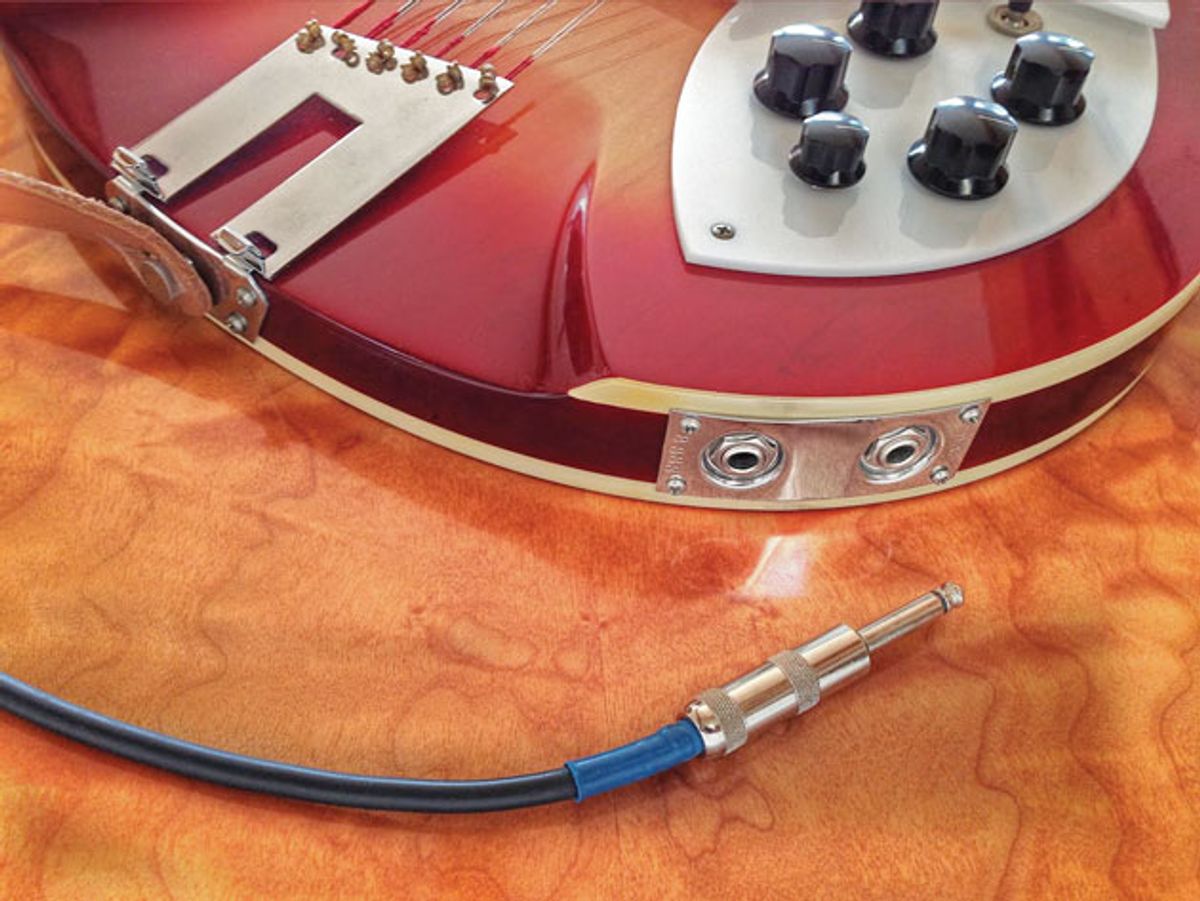
It’s no wonder something as mundane as the lowly output jack might go largely unnoticed by innovators.
We guitarists spend an inordinate amount of time and money chasing the sexiest new effects and guitar add-ons. It’s no wonder something as mundane as the lowly output jack might go largely unnoticed by innovators. Most of us only think about that little part of the instrument when we can’t easily find it. Have you ever wished it were different? Did the jack and plug start out exactly as they are seen today? Is there a better system waiting in the wings to be discovered? Over the short history of the electric guitar, the actual output system hasn’t changed much, but its location is still part of the designer’s thought process.
It’s not surprising that some of the very first electrics—like the 1930s-era Audiovox lap steel—featured a fixed cord like a toaster or other appliances of the day. The cloth-covered wire emerged from the side of the instrument and terminated with a “phone” plug—the 1/4" device we have come to expect. That plug and its phone-jack mate were developed in the late 19th century for telephone switchboards. By the 1930s, the jack and plug had been adapted for other burgeoning technologies like radio and “public address” (PA) sound systems.
Lloyd Loar’s Vivi Tone company made some of the most famous early amplified guitars, and they used a pair of small pin-jacks on the back of the body, or sometimes on the bridge itself. The two output wires then merged into a single cord that terminated at the amp end with a single phone plug. Other primeval electrics employed a connector known as a “screw-on” that used a 5/8"-27 thread, which could be used with a likewise outfitted cord. This configuration is often seen on lap steels and microphones of old, giving rise to its nickname “vintage microphone connector.”
As the phone jack became the standard, instrument designers looked for the most useful and efficient place to locate them. The jacks were originally designed and manufactured for mounting on thin sheet-metal panels, so that limited where they could be placed on a wooden guitar—especially solidbodies. It’s interesting to examine the clever cost-saving design choices that appear on different guitars.
The early jazz-box guitars had thin sides that allowed the jack to be mounted through a simple 3/8"hole, and this is what you’d see on a Gibson ES-175, for example. The ES-335, however, has a thin maple-plywood top that provides a fairly robust mounting point right on the front of the guitar. This allows the jack hole to be drilled at the same time as all the other controls on the face of the guitar, thereby saving time in the process.
Solidbody guitars provide a different challenge for the instrument builder because without a “naturally” occurring thin area, one must be configured. The obvious choice would be to use the same cavity as the controls, which share the same limited options for mounting as the jack. This is seen on the Gibson SG. If a design requires a secondary rout for the jack—either on the face or the side of the guitar—a channel for the wires needs to be planned too. If the jack rout is close enough to the control cavity, it may be a simple matter of allowing it to breach the control rout internally and eliminate a wire-hole drilling operation.
In the case of a side rout or hole, most designs call for a mounting plate of some kind. This can be a thin piece of plastic or metal attached by wood screws (like a Les Paul) or a round insert (like a Telecaster). Fender—well known for its manufacturing-friendly designs—began with the Esquire/Tele, which required a separate rout and plate for the jack. The pickups, pickguard, controls, and output were all independent items.
Mounting to a pickguard is an excellent choice that reduces cost and allows the entire electronics package to be sub-assembled offline, and then mated to the finished guitar in almost a single operation. In 1954, the Stratocaster placed the controls and pickups on a single-mounting plate (the pickguard), yet the output jack was still a separate entity. By 1957, however, the redesigned Precision bass had solved this complexity by mounting the output directly on the pickguard. Unfortunately, the P-bass pickups were screwed to the body, so it was a labor trade-off, I guess.
Also of note is the use of more than one output jack on a single instrument. My 1991 DuoTone design used a pair of 1/4" jacks—one for a magnetic and one for a discrete-piezo output. The Rickenbacker Rick-O-Sound is a 2-channel arrangement using a separate 1/4" stereo jack. Inserting a “Y” cord with true stereo into the Rick-O-Sound output sends the neck and bridge pickups to separate mono output plugs at the cord’s opposite end. The “standard” jack on a Ric is exactly like any other instrument, and both it and the stereo output are mounted to a metal plate at the body’s edge.
Over the decades since the electric guitar arrived, there have been a number of attempts to add flexibility with multiple outputs, and even a few guitars with USB and other computer connections like the iGuitar with its 13-pin connector. Still, guitar builders cling to the tried-and-true 1/4" audio connector from 1878. For reliability and strength, it’s hard to beat.
So will future technology eventually force the century-plus-old phone jack aside? Your guess is as good as mine, but I’m not betting any cash on it.